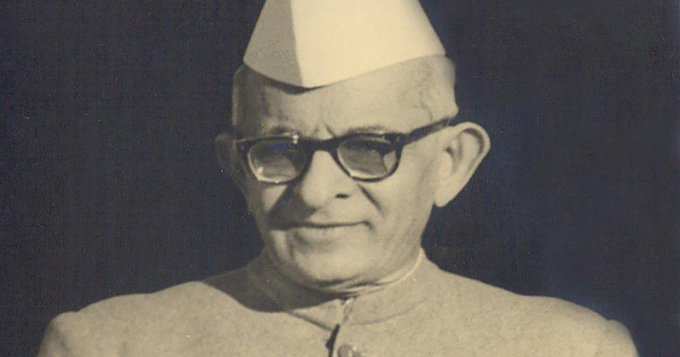History News Desk !!! Kanhaiyalal Maniklal Munshi (English: Kanaiyalal Maneklal Munshi, born: December 29, 1887; Death: 8 February 1971) India’s freedom fighter, politicians, law experts and Gujarati, English, Hindi writers and educationists, who were the Home Minister of Bombay , He was also the Governor of Uttar Pradesh. He held the post of Food Minister of the Government of India. He established the Bharatiya Vidya Bhavan in Mumbai. He also took over Hans with Munshi Premchand.
Life introduction
Kanhaiyalal Munshi was born in a highly educated Bhagarava Brahmin family of Bhadoch (Gujarat). Kanhaiyalal’s early education was done by his mother’s religious songs and stories. Kanhaiyalal Munshi received the association of Arvind Ghosh (Maharishi Arvind) as a teacher during his Mahavidyaliya education in Baroda. With this contact, Munshi’s mind raised a resolution of armed rebellion against colonial rule. At the same time, this contact also filled the heart of Munshi in the heart of India’s glorious cultural, intellectual and spiritual heritage. In 1910, Munshi received the LLB degree from Bombay University and became one of the major lawyers of the Bombay High Court in a very short time after starting advocacy. Munshi had an extraordinary mastery on Hindu law because he had acquired this knowledge not only from legal books but from serious and rational studies of corresponding and theology.
Establishment of Bharatiya Vidya Bhavan
About ten years before independence, he established the Bharatiya Vidya Bhavan in November 1938 to cherish the present and future of India from the cultural and ideological renaissance of India. The Bharatiya Vidya Bhavan, established with contribution of Rs 250 per year by Munshi and his three friends in 1938, today has about 120 centers and more than 350 educational institutions associated with them. Many institutions related to the building have the system of education, information technology, management, communication and journalism, science, art and commerce. But above these, the building has given the most attention to the study and teaching of Indian learning.
Contribution to freedom struggle
Kanhaiyalal Munshi, who was eager for India’s freedom, joined Annie Besant’s home rule movement during the first World War, but later decided to support the Congress when Gandhi came in contact. Kanhaiyalal Munshi ji took part in the 1928 Bardoli Satyagraha under the leadership of Sardar Vallabhbhai Patel. Similarly, Munshi participated in the 1930 salt Satyagraha. He also suffered six months of imprisonment due to participation in salt satyagraha. In 1931, Munshi was sentenced to two years to participate in the Civil Disobedience Movement. In 1937, Kanhaiyalal Munshi was appointed as a minister in the first elected government of the then Bombay Presidency. Although his personal choice was the Ministry of Law and Education, he was entrusted with the responsibility of important departments like Home Ministry. This is a matter of era when the English rule considered Indians completely disabled for self -government. She wanted to see Indians failed, especially on communal issues. But Munshi presented a sample of efficiency, fairness and justice during his home minister’s tenure.
Contribution to constitution
For independent India, a mixture of idealism and realism was needed among the creators of new constitution-building. Kanhaiyalal Munshi, full of political insight and sharp legal intelligence, was considered the most efficient in this task. Among the committees made for constitution-building, Munshi was made members of the most eleven committees. In the draft committee of constitution forming under the chairmanship of Dr. Bhimrao Ambedkar, the law was jointly written by Munshi and Ambedkar in the law. Similarly, despite many hurdles and disruptions, Munshi played the most prominent role in getting Hindi and Devanagari script the place of the official language of the new Indian Union. This decision of the Constituent Assembly is celebrated as Hindi Day on 14 September 1949. Kanhaiyalal Munshi was to develop a federal system under a strong center in constitution-building, in the context of the difficulties of merger of indigenous princely states in India and in this innumerable diversity, other constitutional builders including Munshi, including Munshi, The strong central government was considered indispensable. The first line of the Indian Constitution for Kanhaiyalal Munshi, the phrase ‘India that is Bharat’, means not only a terrain but an endless civilization, a civilization that always survives through its self-regulation.
Governor of Uttar Pradesh
In 1947, the Nizam of Hyderabad demanded the recognition of an independent nation as an independent nation, and the Government of India appointed Munshi as Representative (Agent General) of the Government of India in Hyderabad to solve this problem. After the merger of Hyderabad state in India, the then Home Minister Sardar Patel praised the important role of Munshi in this campaign. After completing his hard work, Munshi also wrote a book called his memoir the & an Ira (Hyderabad Memoors) on it. After Dr. Rajendra Prasad was elected President, Munshi became the Minister of Agriculture and Food in his place in the Union Cabinet. Meanwhile, he started many effective efforts to conserve environment and forestry. Every year, the Van Mahotsav held in July is a result of the same efforts of Kanhaiyalal Munshi. The reconstruction of Somnath temple in independent India was also on the agenda of Munshi. Due to his activism, Prime Minister Pt. Jawaharlal Nehru told Kanhaiyalal Munshi after a cabinet meeting that I do not like the efforts you are making to re -establish the Somnath temple. From 1952 to 1957, Kanhaiyalal Munshi was the Governor of Uttar Pradesh State. In 1959, Munshi resigned from the membership of the Congress party and joined the Swatantra Party of Chakravarti Rajagopalachari. Shortly thereafter, he took membership of the Bharatiya Jana Sangh.
Literary introduction
The achievements of Kanhaiyalal Munshi as a creator and editor are unique, such as the editing of Young India newspaper and the editing of Hans magazine with Munshi Premchand. Kanhaiyalal Munshi was an extraordinary litterateur. He composed more than a hundred outstanding texts in Gujarati, Hindi and English. As a literature servant, he also led the Gujarati Sahitya Parishad, Sanskrit Vishwa Parishad and Hindi Literature Conference. Munshi also established several educational institutions as an educationist. The most notable of these is the establishment of the Indian Institute of Agricultural in Anand, which is a full university today.
Death
Kanhaiyalal Maniklal Munshi died on 8 February 1971.










